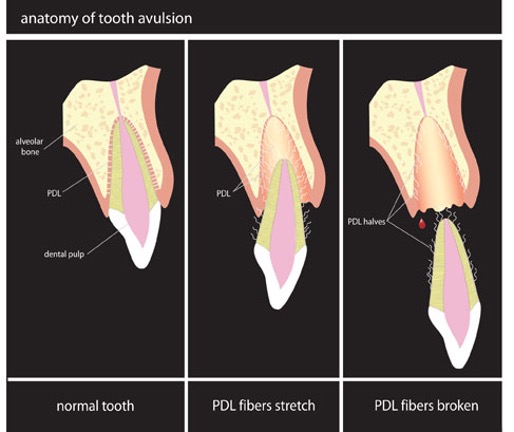It is common for kids and adults to get hurt during any form of sports, particularly contact sports. Unfortunately, the main area of damage is often the face. This makes athletic injuries a major link between sports and dentistry. Sports-related dental injuries can range from a minor chip to a tooth or “avulsion”, which is the complete loss of a tooth with the root attached.
In this column, we will discuss immediate steps to take if a tooth gets knocked out.
If the entire tooth has been knocked out, it’s important to act swiftly and carefully to increase the chances of saving the tooth.
If a child has lost a tooth, confirm whether it is a permanent or baby tooth. Baby teeth are not re-implanted since they have very short roots and will be eventually lost. If it’s a “permanent tooth,” then follow the steps below:
Never touch the tooth by the root. The root contains important fibers, called periodontal ligaments that are necessary for proper healing and reattachment. Handle the tooth by the chewing or crown surface area and not the root.
Do not use soap or chemicals. Don’t scrub or dry the tooth, and don’t wrap the tooth in a tissue or cloth. If the tooth is visibly soiled, rinse briefly with tap water, however do not attempt to clean or scrub the tooth. Immediately put the tooth back into the tooth socket, if possible. After trying, whether able to or not go immediately to a dentist or the nearest emergency department and be sure to take the tooth with you.
While heading to a dentist or Endodontist put the tooth back in the mouth next to the cheek or in a small container of milk. The idea here is for the root to stay moist and not pick up outside germs.
Thus far you would note everything one should do is time sensitive. This is because it’s an important factor in the survival of the tooth. If the tooth is replaced into the socket within five minutes of being knocked out, it is likely to survive. After 5 minutes and up to 60 minutes, there is a good survival rate as long as the tooth remains moist. If the tooth is out of the mouth for more than 60 minutes, the chance for survival decreases significantly.
At the dentist’s office the tooth likely will be re-implanted and splinted to the adjacent teeth for two to eight weeks. During that time, a root canal will be necessary for long-term survival of the tooth.
Despite the best strategies for saving a tooth that was knocked out, the best option is prevention in the first instance. An athlete is 60 times more likely to suffer dental injuries when not wearing a mouthguard, according to the American Dental Association. A properly made mouth guard can protect the teeth by cushioning the impact and spreading the forces.
Mouthguards today are very inexpensive; ready-made, boil-and-bite or custom-formed by a dentist. It can add a tremendous amount of protection and should be used with all contact sports that has the potential for mouth injury.
Quick action is critical when a tooth is knocked out. Putting measures in place like a mouthguard to protect the teeth is likely to avoid such emergencies and trauma. Remember, prevention is certainly better and cheaper than cure.
Dr. Kendal V. O. Major is Founder and CEO of Center for Specialized Dentistry which is a comprehensive family dental practice operating in Nassau and Freeport. He is the first Bahamian Specialist in gum diseases and dental implants since 1989. He also is a certified Fastbraces provider. His practice is located at 89 Collins Avenue, Nassau at (242)325-5165 or [email protected].








